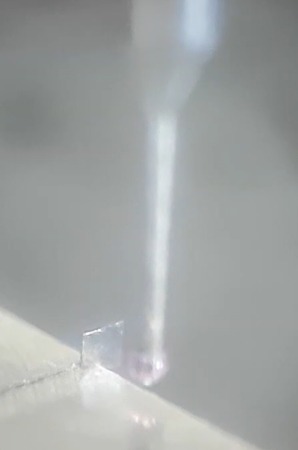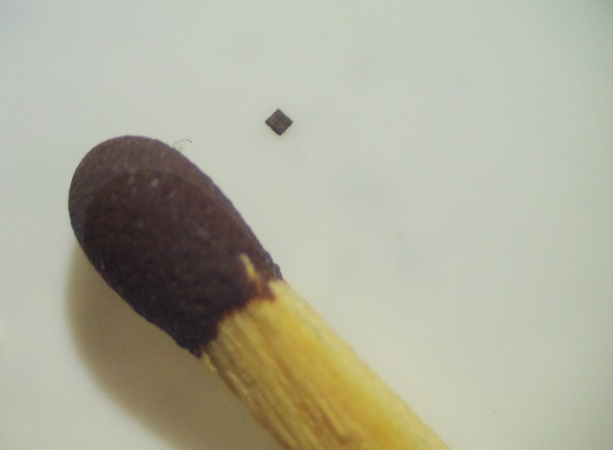 During spring 2020 Zeiss announced their Measuringhero Awards with prizes to win in seven different categories. “In honour of the metrologists who deal with everyday measuring challenges” Zeiss stated.
During spring 2020 Zeiss announced their Measuringhero Awards with prizes to win in seven different categories. “In honour of the metrologists who deal with everyday measuring challenges” Zeiss stated.
One category was for the smallest object measured on a Zeiss CMM.
The smallest measured object was just 0.4 x 0.4 x 0.03 mm. This entry was made by Nobby Assmann from the Netherlands. He runs his own shop, together with his parents, without any additional staff. Their company Assmann Verpaningstechniek is a precision tool room that performs contract work including wire & die sinking EDM, honing, flat lapping, and surface & cylindrical grinding.
 Nobby’s measuring lab inspect the parts they make themselves, and in addition performs contract inspection work for customers from the Netherlands and Belgium; often for companies that don’t have a CMM.
Nobby’s measuring lab inspect the parts they make themselves, and in addition performs contract inspection work for customers from the Netherlands and Belgium; often for companies that don’t have a CMM.
The measuring lab is Nobby’s domain: “I have been programming CMM’s since the age of 11 – when I was at my parents’ shop during the evenings and weekends. Now, 30 years later, running the CMM remains is a big passion.”
The winning component is a part of a hearing aid. Nobby comments “My clients client produces hearing aids – so I guess it’s some sort of spring or an electrical contact. We usually don’t get to hear what a part does. We just produce according to print.”
He produced the part himself. He made a small punch from hardened tool steel, by wire EDM and lapping. The punch was used to cut a couple of dozen parts from 0,03 mm stainless steel sheet with a hardness of 50 Rockwell C. Nobby used the punches with a rubber cushion, “an old toolmakers’ trick” Nobby claims.
How to Measure a Part so Small?
Clamping the part was the hardest bit, Nobby says: “I had to use a pair of tweezers under the microscope, to clamp the part. Most parts need inspection over their entire surface – leaving very little room for clamping. This part was no exception. I had a quarter of the 0,4 x 0,4 mm in a vice, allowing room for the probes on all 6 sides of the part. For the best results you strive to measure a part in one run.”
To access all 6 sides of the small square plate, Nobby used 2 styli of only 0,3 mm diameter, in a star configuration: One vertically down and one horizontal. In order to see the part and the styli, he used a stereo microscope. “I have used a microscope on the CMM before, when inspecting a Swiss watch part. It´s a bit tough to set it up – without hitting it with the CMM – but it’s necessary: you need to see what you’re doing. Once you hit the first few points manually, you can proceed on the PC. Adding a CNC measuring strategy isn’t much different from larger parts.” Nobby adds.
 Nobby has owned a Zeiss CMM since the beginning of this year. The Zeiss Contura is equipped with the VAST XT active scanning head, which is capable of very accurate yet rapid scanning. He even did some scanning on the surface of the small part. He posted a short video on YouTube about his entry for the Zeiss award – not knowing he was going to win. At the end of this video you get an impression how small the part is: much smaller than the tip of a match. To the naked eye it looks more like a piece of dirt, rather than a technical part.
Nobby has owned a Zeiss CMM since the beginning of this year. The Zeiss Contura is equipped with the VAST XT active scanning head, which is capable of very accurate yet rapid scanning. He even did some scanning on the surface of the small part. He posted a short video on YouTube about his entry for the Zeiss award – not knowing he was going to win. At the end of this video you get an impression how small the part is: much smaller than the tip of a match. To the naked eye it looks more like a piece of dirt, rather than a technical part.
All ten category winners were to have been invited for a trip to Germany in October. Apart from an award ceremony the measuring heroes were awarded with a stay in a five star hotel; a day of Porsche Travel Experience, driving Porsches on the German roads – including the Autobahn without speed limit. They will also receive a day of personal training at Zeiss’ headquarters. Due to the Covid19 situation these events are postponed. Nobby says: “I was really looking forward to this trip: especially that day of training. And meeting the other winning metrologists. I wonder if they are just as mad about their job, like I am.”
For more information: www.zeiss.com/metrology
Tags: 3d vina, hiệu chuẩn, hiệu chuẩn thiết bị, máy đo 2d, máy đo 3d, máy đo cmm, Measuring Hero – Sweating The Small Stuff, sửa máy đo 2d, sửa máy đo 3d, sửa máy đo cmm
